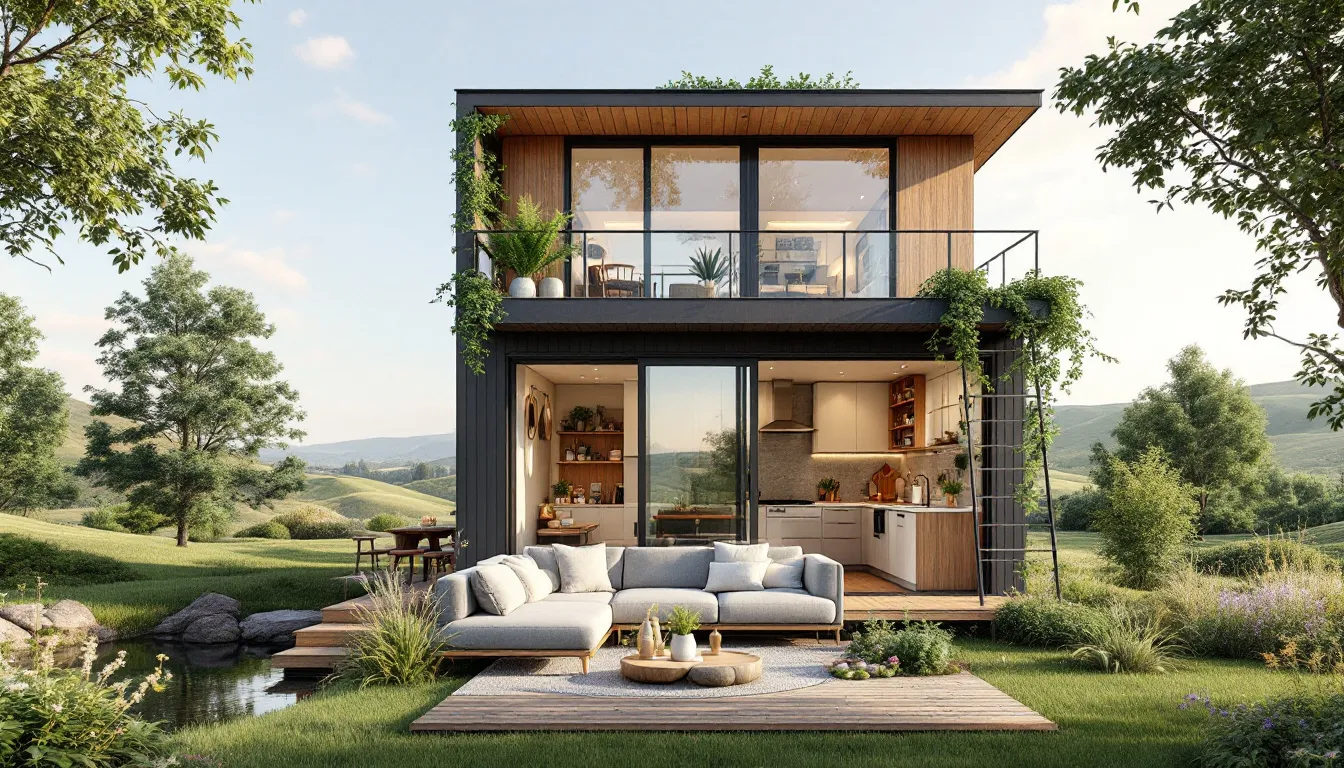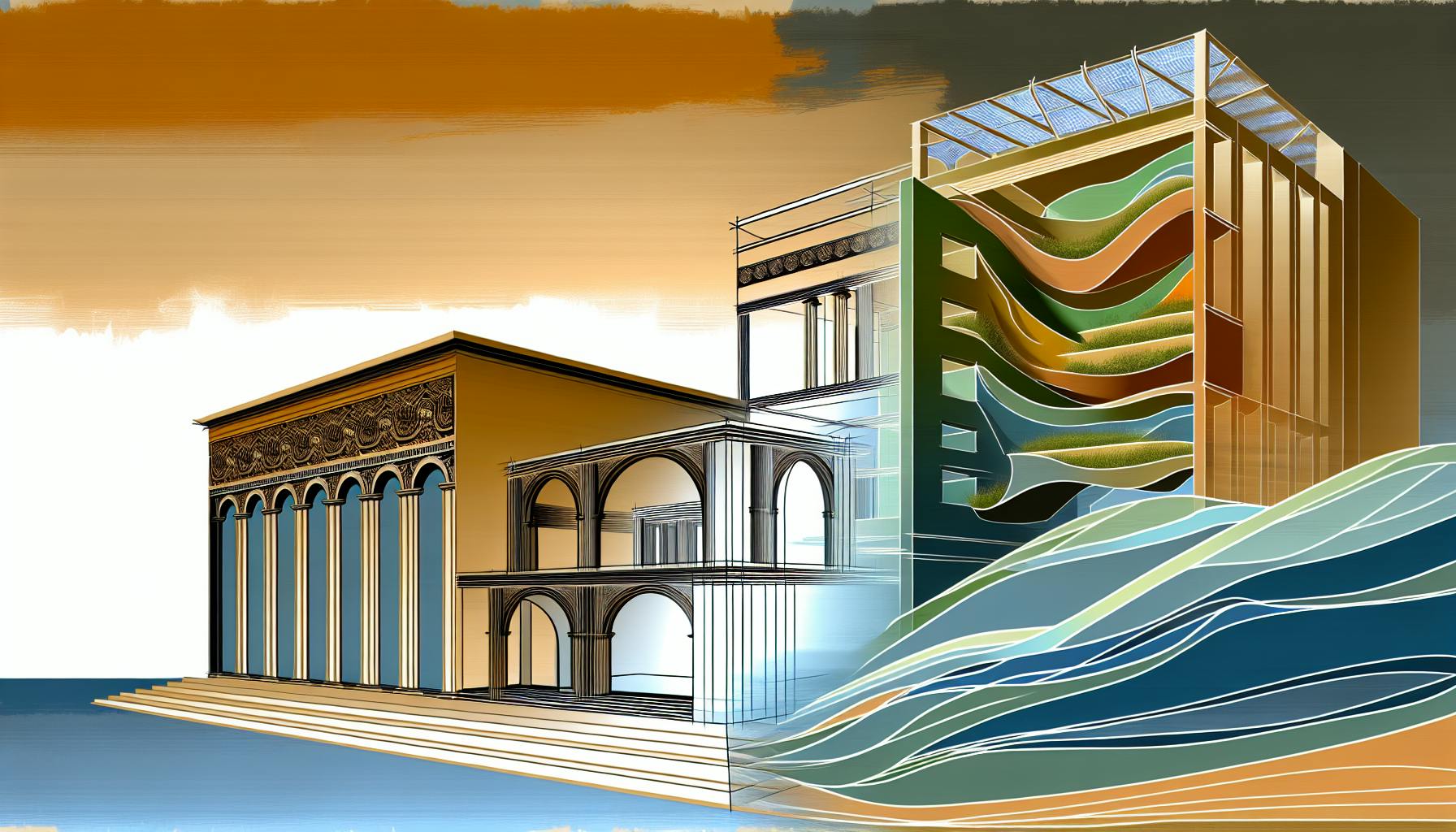Want durable, energy-efficient buildings? Start by choosing materials that match your climate.
Climate impacts how materials perform over time, from cracking in extreme temperatures to mold in humid conditions. This guide simplifies material selection for different climates to help you build structures that last longer, save energy, and reduce costs.
Key Takeaways:
- Hot-Dry Areas: Use materials like adobe, rammed earth, and light-colored surfaces to manage heat.
- Hot-Humid Regions: Opt for moisture-resistant materials like fiber cement or engineered wood to prevent damage.
- Cold Climates: Prioritize insulation and freeze-thaw-resistant options like triple-pane windows and spray foam insulation.
- Mixed Climates: Composite materials work well for areas with temperature swings and moisture challenges.
Quick Tip: Tools like BSD SpecLink E and Canvas can help you find climate-specific options fast.
This guide also covers eco-friendly insulation, moisture management strategies, and real-world examples of climate-smart buildings. Ready to build better? Let’s dive in.
Design Your Next Eco-Home with Climate-specific Wall Systems
Material Selection Guide by Climate Zone
Choosing the right materials for construction depends heavily on the climate zone. Each region presents unique challenges and demands specific solutions to ensure buildings perform efficiently. Below, we break down the best materials for each U.S. climate zone.
Materials for Hot-Dry Regions
In states like Arizona and Nevada, where summer temperatures regularly soar above 90°F for over 67 days a year, materials with high thermal mass shine. These materials help regulate indoor temperatures by absorbing heat during the day and releasing it at night.
- Adobe and rammed earth: These time-tested materials excel at maintaining comfortable indoor temperatures by managing heat flow.
- Concrete and concrete blocks: While effective at absorbing heat, they can retain warmth longer than desired, so placement and usage are key.
- Light-colored surfaces: Brightly finished exteriors can reflect a large portion of radiant heat, reducing heat absorption.
"You must consider what you need to be resilient against. Ultimately, you need to be resilient against factors outside of your control", says Craig Miles, Director of OSB Sales & Marketing at LP Building Solutions.
Take Phoenix as an example. Smart systems like automated shading and advanced controls have become essential in battling the intense sunlight. But as we shift to humid climates, the priorities change.
Materials for Hot-Humid Areas
In coastal and southeastern regions, high moisture levels create unique challenges. Here, materials must balance durability, affordability, and ease of maintenance. Below is a breakdown of some popular options:
| Material Type | Cost per Sq. Ft. | Durability Rating | Maintenance Needs |
|---|---|---|---|
| Fiber Cement | $5–$15 | Excellent | Every 10–15 years |
| Engineered Wood | $4–$9 | Very Good | Moderate |
| Composite | $6–$12 | Excellent | Minimal |
| Aluminum | $3–$8 | Good | Occasional |
For interiors, moisture-resistant products like USG Sheetrock Brand UltraLight Mold Tough Drywall (rated 4.5/5 stars from 1,576 reviews) are highly effective at preventing damage caused by high humidity. However, when it comes to cold climates, the focus shifts to insulation and freeze protection.
Materials for Cold Regions
In cold areas like North Idaho, materials must withstand harsh freeze-thaw cycles while offering robust insulation. Key construction techniques include:
- Triple-pane or high-quality double-pane windows: These significantly reduce heat loss during winter months.
- Spray foam or dense-pack cellulose insulation: Both options provide excellent thermal protection, keeping homes warm and energy-efficient.
- Engineered wood: Designed to handle extreme temperature shifts without warping or cracking.
"Homes built for their environment simply perform better. They stay more comfortable year-round, use energy more efficiently, and hold up longer with less repair", explains Atlas Building Group.
Now, let’s turn to regions with unpredictable weather patterns.
Materials for Mixed Climates
In areas with both hot summers and cold winters, construction materials must handle a wide range of conditions. Composite materials are particularly well-suited for these regions, offering durability, temperature adaptability, and effective moisture management.
Material Performance Measurements
Understanding how materials perform in different climates is crucial for making smart choices, especially when it comes to building durability. Studies reveal that up to 90% of building durability issues are linked to moisture-related problems. This makes evaluating performance metrics a key step in ensuring long-lasting results.
Heat and Moisture Ratings
The thermal properties of building materials play a big role in energy efficiency and overall comfort. Here's a quick look at some important metrics:
| Performance Metric | Unit | Why It Matters |
|---|---|---|
| Thermal Conductivity | W/(m·K) | Indicates how quickly heat moves through a material |
| Moisture Content | % | Shows how much water a material can absorb |
| Density | lb/ft³ | Reflects the material's compactness |
| Specific Heat | BTU/(lb·°F) | Measures the material's ability to store heat |
Moisture has a significant impact on thermal performance. For example, a 15% increase in moisture content can raise the thermal conductivity of mineral wool by as much as 446%. Similarly, when aerated concrete's moisture content reaches 100%, its thermal conductivity can quadruple.
To better understand these effects, modern testing methods simulate real-world conditions. Hygrothermal analysis, for instance, predicts how materials handle cycles of wetting and drying. Ignoring moisture absorption can lead to serious errors - like overestimating peak heating loads by 210% or underestimating heat flux from latent heat effects by 59%.
Weather Resistance Factors
A material's ability to withstand weather conditions is a critical aspect of its durability. Here are some of the main factors to keep in mind:
UV Stability: Sunlight can heat materials to over 140°F (60°C), which speeds up degradation. Advanced polymers like Hypalon are highly resistant to ozone exposure, tolerating concentrations as high as 1 part per 100 parts of air. In contrast, many elastomers begin to degrade at just 1 part per million.
Freeze-Thaw Resilience: For areas with frequent temperature swings, freeze-thaw testing evaluates how well materials maintain their shape, strength, and resistance to moisture penetration during repeated freezing and thawing cycles.
Moisture Management: Proper moisture control is key. Materials like spruce plywood can improve cooling energy efficiency by 20–30%. This makes them a smart choice for reducing energy costs in humid climates.
In coastal regions, salt exposure becomes another important factor. Accelerated weathering tests simulate years of wear and tear, helping predict how materials will hold up over time and what kind of maintenance they’ll need in salty, humid environments.
Local and Green Material Options
Choosing sustainable materials goes hand-in-hand with climate-specific strategies to create buildings that are both durable and energy-efficient. With buildings responsible for 42% of global emissions, using eco-friendly materials is a crucial step toward reducing their environmental impact.
Green Insulation Materials
When it comes to insulation, eco-friendly options are not only effective but also resource-conscious. Here are some standout materials:
| Material Type | R-Value/inch | Best Climate Zone | Key Feature |
|---|---|---|---|
| Sheep's Wool | R-3.6 | Cold/Mixed | Regulates moisture naturally |
| Hemp | R-3.5 | All zones | Dense and versatile |
| Cellulose | R-3.7 | All zones | Made from 85% recycled paper |
| Denim | R-3.5 | Dry regions | Composed of 80% recycled fabric |
In Madison, Maine, TimberHP has set up a facility that transforms local wood waste into high-performance insulation.
"We believe solutions lie close to home".
For instance, Icynene insulation has been shown to cut home energy bills by 30–50% annually, while cork insulation stands out with its negative carbon footprint.
Beyond insulation, using locally sourced materials can further improve sustainability by addressing regional climate needs effectively.
Local Material Solutions
Incorporating regional materials not only supports sustainability but also enhances building performance by aligning with the specific demands of different areas. Tailoring material choices to the eight IECC climate zones can significantly reduce emissions and improve efficiency.
"Choosing the right insulation isn't just about meeting regulations - it's about optimizing energy efficiency, lowering costs, and ensuring long-term building performance", says Matt Lee from Rmax.
Cold Climate Solutions:
- Wood fiber insulation is ideal for northern states, offering excellent moisture management.
- Clay blocks are a greener alternative to concrete, with 10–20 times lower CO₂ emissions.
Humid Region Applications:
- Moisture-resistant composites improve durability and help control indoor humidity levels.
Coastal Area Innovations:
- Recycled plastic materials are a game-changer, reducing greenhouse gas emissions by 95% compared to concrete blocks.
"Everything we design is a response to the specific climate and the culture of a particular place".
"The best way to insulate a building is to have a well-defined thermal boundary".
sbb-itb-1be9014
Selection Tools and Examples
Advancing sustainable strategies with local materials, digital tools have become indispensable in refining material selection. These tools integrate regional performance data, enabling architects and builders to make smarter, climate-appropriate choices while taking inspiration from successful regional projects.
Digital Material Selection Tools
Digital tools now play a critical role in identifying materials tailored to specific climate conditions. They allow for rapid and precise selection, ensuring buildings are designed to perform efficiently in their unique environments.
Here’s a look at some tools designed for climate-based material selection:
| Tool Name | Key Features | Best Use Case |
|---|---|---|
| BSD SpecLink E | Edit-in functionality, climate zone filtering | Complete material specifications |
| Canvas | LiDAR scanning, 3D modeling | Existing building analysis |
| Cyncly Room Survey | Bluetooth laser integration, real-time measurements | Accurate space planning |
| MeasureOn | Digital sketching, laser surveying | Floor plan creation |
"A&D spec software streamlines both architecture and interior design projects. It provides a seamless organization, enables instantaneous and collaborative access to project elements, and facilitates enhanced communication among project participants."
- Jacob Slevin, Founder of Designer Pages
These tools not only simplify the selection process but also highlight practical applications through region-specific case studies.
Regional Building Examples
Projects worldwide illustrate how thoughtful material selection tailored to local climates can dramatically enhance building performance.
Hot-Dry Climate Success
The Cowboy Modern Desert Eco-Retreat in Pioneertown, California, is a standout example. This project utilized reclaimed lumber from local demolition sites, paired with passive solar design strategies, to effectively reduce energy use in the harsh desert environment.
Cold Climate Innovation
In Kennebunkport, Maine, the Binnacle Hill Residence by Whitten Architects showcases smart material choices for cold regions. With high thermal mass polished concrete floors, strategically placed south-facing windows, and specialized insulation, the design optimizes energy efficiency.
Urban Climate Response
Boston’s 121 Seaport building tackles urban climate challenges through a thoughtful combination of materials and design. Features include elements to reduce solar heat gain, materials engineered to withstand strong winds, and rainwater collection systems to manage water resources efficiently.
"Increasingly architects and designers are realizing that building designs need to reflect the conditions of the area in which they are located."
- Prasoon Shrivastava, CEO and Founder of Prasoon Design Studio
In Niamey, Niger, the United4Design team’s Niamey 2000 project demonstrates how traditional materials can meet modern demands. Locally sourced unfired earth bricks were used to cut costs, create jobs, and naturally regulate indoor temperatures.
These examples underscore how combining digital tools with thoughtful material selection can lead to buildings that align with their local climate, achieving energy savings of up to 90%.
Summary
Selecting materials tailored to specific climates plays a critical role in creating energy-efficient and durable buildings. Considering that buildings contribute to 30% of greenhouse gas emissions in the U.S., and heating and cooling account for roughly 40% of household energy use, choosing the right materials can make a big difference. For instance, reflective metal roofing can reduce heat absorption by as much as 30%, significantly improving energy efficiency and lifespan.
"When navigating the complexities of roofing, it's essential to understand how climate zones affect material performance. By taking the time to analyze your specific climate and building codes, you can ensure that your roofing choice not only meets aesthetic preferences but also delivers the durability and efficiency your home requires." - Joe Schuer, Sure Roofing and Siding
Here’s a quick look at climate types and the materials best suited for each:
| Climate Type | Best Materials | Performance Benefits |
|---|---|---|
| Hot-Dry | Concrete, Clay | Reflects heat, provides thermal mass |
| Cold | Wood, ICFs | Excellent insulation, weatherproofing |
| Humid-Coastal | Treated wood, Fiber cement | Resists moisture and salt damage |
| Temperate | Brick, Stone | Balanced durability and insulation |
Research also highlights the value of bio-based and climate-suited materials, which could reduce emissions by up to 40% by 2050.
"Good old materials like earth, straw or hemp can replace carbon-intensive materials for some sections of buildings. The key is to put each material in the best place in a construction to benefit from its specific advantages"
Metal roofs, for example, can reflect up to 70% of solar energy, while cool roofing systems have been shown to lower air conditioning costs by 16.6%. These findings underscore the importance of aligning materials with climate conditions to maximize efficiency and cut expenses.
FAQs
How can I find out which climate zone my building site is in to choose the right materials?
To figure out your building site's climate zone, you can use tools like the IECC climate zone map or state-specific resources, such as those from the California Energy Commission. These tools make it easy to pinpoint your zone based on your location, whether by zip code or county.
Understanding your climate zone is crucial when it comes to choosing materials that can handle local conditions effectively - be it for insulation, managing moisture, or maintaining temperature control. For design ideas or to explore architectural styles that work well in various climates, platforms like Architecture Helper provide helpful insights to steer your planning process.
What are some sustainable insulation materials that work well in various U.S. climates?
Eco-Friendly Insulation Materials for U.S. Climates
When it comes to insulation, some materials stand out for being both effective and environmentally conscious. Here are a few options that work well across various climates in the U.S.:
- Cellulose: Crafted from recycled paper, this material offers strong thermal performance while being biodegradable, making it a smart choice for sustainability.
- Sheep’s Wool: This natural insulator not only keeps spaces comfortable but also helps regulate moisture and boasts impressive durability over time.
- Hemp Insulation: As a renewable resource, hemp provides solid thermal resistance and performs well in both hot and cold environments.
These options don’t just enhance energy efficiency - they also contribute to reducing environmental impact, aligning perfectly with sustainable building goals.
How can digital tools help in choosing building materials suited to specific climates?
How Digital Tools Help Choose Climate-Specific Building Materials
Digital tools have made it easier than ever to select materials that suit specific climate conditions by offering real-time data and personalized suggestions. Take BSD SpecLink E, for example - it integrates directly with CAD systems, automatically recommending materials tailored to the unique needs of a project. This not only ensures the materials are suited to the local climate but also simplifies teamwork by keeping everyone on the same page.
Similarly, platforms like Canvas provide comprehensive frameworks for evaluating materials. They factor in things like environmental impact, design goals, and climate considerations, giving architects and designers the insights they need to make smarter choices. These tools don’t just improve functionality; they also support more sustainable and climate-conscious architectural designs.


